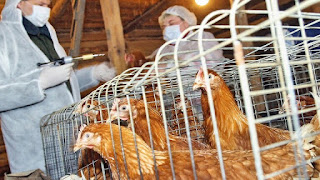ARTICLE AD BOX
-
Dr. Sergei Voznesensky, associate professor at the Faculty of Medicine at the Russian Peoples' Friendship University, points out that the bird flu virus is close to crossing the species barrier.
Dr. Sergei Voznesensky, associate professor at the Faculty of Medicine at the Russian Peoples' Friendship University, points out that the bird flu virus is close to crossing the species barrier.
He says: “The letter H in the name of the virus stands for hemoglitinin, and the letter N stands for neuraminidase. There are different types of them. A person can get sick if the virus contains H1, H2, H3, N1, and N2. Infecting someone with the H5N2 virus means that the virus is close to overcoming the barrier.” between species.
The doctor points out that there is currently talk about a human becoming infected with the H5N2 virus from a bird.
He says: “The problem of bird flu has existed for decades. We fear that the virus will mutate, and what is called rearrangement will occur, that is, the exchange of identical gene sections, and then a new virus will appear that can be transmitted from one person to another. That is, the aerosol mechanism for airborne transmission will work, and this will overcome "The virus is right at the species barrier, and this would be a serious emergency. Of course, it's alarming for one person to be infected by a bird, but it could be several decades before a catastrophe occurs, meaning nothing supernatural happens."
It is noteworthy that the World Health Organization's information office had announced earlier that Mexico had recorded the first human case of bird influenza A (H5N2) virus, which led to death.
In preparation for a potential pandemic a comprehensive study of vaccines against bird flu
Health experts have warned that the bird influenza virus has adapted to spread from one person to another, especially after the first reports of its transmission from animals to humans appeared in the United States.
In this regard, a new study is examining the vaccines currently being developed to protect us if a new pandemic ever occurs.
Experts indicated that there are several hundred thousand doses stored, remaining from previous experiments. However, there are questions about how effective it is against the latest strains of bird flu, and how quickly production efforts can be scaled up.
Virologists Flavio Faxen and Daniel Perez, from the University of Georgia, analyzed current efforts to prepare for a human pandemic involving current strains of bird flu, and identified several promising options for vaccine development.
“This deep dive into the bird flu vaccine landscape shows that vaccination remains the primary defense against the spread of these viruses,” Faxen says.
“Exploring and using a variety of vaccine bases is critical to enhancing pandemic preparedness and mitigating the risk of avian influenza,” the study said.
The research team studied vaccines that were developed using dead versions of the virus. Tests, including a study in mice infected with the H5N1 virus, have shown that it provides high levels of protection.
There are live attenuated influenza vaccines (LAIVs), which use a weakened form of the virus to prepare the body to protect against more serious forms. These vaccines usually create a more comprehensive immune response, and have also achieved promising results against H5N1.
The team looked into newer types of vaccine technology, including virus-like particle (VLP) vaccines that attempt to (safely) mimic real viruses.
The researchers said that the vaccine research conducted so far is encouraging. But deploying these vaccines, if necessary, will require cooperation across many different countries and agencies, which the World Health Organization is working to ensure.
The study was published in the journal Human Vaccines & Immunotherapeutics.
.png)
 5 months ago
4
5 months ago
4









 English (US)
English (US)